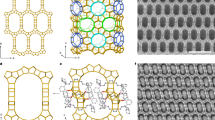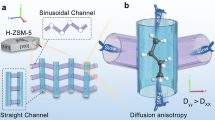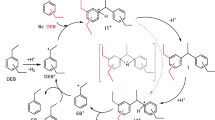Abstract
Zeolites are industrially important catalysts and adsorbents, typically synthesized using specific molecules known as organic structure-directing agents (OSDAs). The templating effect of the OSDAs is pivotal in determining the zeolite polymorph formed and its physicochemical properties. However, de novo design of selective OSDAs is challenging because of the diversity and size of the zeolite–OSDA chemical space. Here we present ZeoBind, a computational workflow powered by machine learning that enables an exhaustive exploration of the OSDA space. We design predictive tasks that capture zeolite–molecule matching, train predictive models for these tasks on hundreds of thousands of datapoints and curate a library of 2.3 million synthetically accessible, hypothetical OSDA-like molecules enumerated from commercially available precursors. We use ZeoBind to screen nearly 500 million zeolite–molecule pairs and identified and experimentally validated two new OSDAs that template zeolites with novel compositions. The scale of the OSDA library, along with the open-access tools and data, has the potential to accelerate OSDA design for zeolite synthesis.
This is a preview of subscription content, access via your institution
Access options
Access Nature and 54 other Nature Portfolio journals
Get Nature+, our best-value online-access subscription
$32.99 / 30 days
cancel any time
Subscribe to this journal
Receive 12 digital issues and online access to articles
$119.00 per year
only $9.92 per issue
Buy this article
- Purchase on SpringerLink
- Instant access to full article PDF
Prices may be subject to local taxes which are calculated during checkout





Similar content being viewed by others
Data availability
All training and validation data, experimental data, hypothetical molecule data and predictions made over the entire known zeolite–hypothetical molecule space are available at Materials Data Facility61. Source data are provided with this paper.
Code availability
The code for developing the ML models, analyzing predictions and screening is available via GitHub at https://github.com/learningmatter-mit/zeobind and via Zenodo at https://doi.org/10.5281/zenodo.15425842 (ref. 62). The Lipari color scheme from Crameri et al.63 was used for the figures.
References
Pérez-Botella, E., Valencia, S. & Rey, F. Zeolites in adsorption processes: state of the art and future prospects. Chem. Rev. 122, 17647–17695 (2022).
Li, Y., Li, L. & Yu, J. Applications of zeolites in sustainable chemistry. Chem 3, 928–949 (2017).
Lobo, R. F., Zones, S. I. & Davis, M. E. in Inclusion Chemistry with Zeolites: Nanoscale Materials by Design (eds Herron, N. & Corbin D. R.) 47–78 (Kluwer Academic, 1995).
Moliner, M., Rey, F. & Corma, A. Towards the rational design of efficient organic structure-directing agents for zeolite synthesis. Angew. Chem. Int. Ed. 52, 13880–13889 (2013).
Li, J., Gao, M., Yan, W. & Yu, J. Regulation of the Si/Al ratios and Al distributions of zeolites and their impact on properties. Chem. Sci. 14, 1935–1959 (2023).
Le, T. T., Chawla, A. & Rimer, J. D. Impact of acid site speciation and spatial gradients on zeolite catalysis. J. Catal. 391, 56–68 (2020).
Hoffman, A. J. et al. Rigid arrangements of ionic charge in zeolite frameworks conferred by specific aluminum distributions preferentially stabilize alkanol dehydration transition states. Angew. Chem. Int. Ed. 59, 18686–18694 (2020).
Pan, E. et al. ZeoSyn: a comprehensive zeolite synthesis dataset enabling machine-learning rationalization of hydrothermal parameters. ACS Cent. Sci. 10, 729–743 (2024).
Schwalbe-Koda, D. et al. A priori control of zeolite phase competition and intergrowth with high-throughput simulations. Science 374, 308–315 (2021).
Simancas, R. et al. Recent progress in the improvement of hydrothermal stability of zeolites. Chem. Sci. 12, 7677–7695 (2021).
Sastre, G. & Daeyaert, F. (eds) AI-Guided Design and Property Prediction for Zeolites and Nanoporous Materials (Wiley, 2023).
Ito, S., Muraoka, K. & Nakayama, A. De novo design of organic structure-directing agents for zeolites using a general-purpose large language model. Chem. Mater. 37, 2447–2456 (2025).
Daeyaert, F., Ye, F. & Deem, M. W. Machine-learning approach to the design of OSDAs for zeolite beta. Proc. Natl Acad. Sci. USA 116, 3413–3418 (2019).
Muraoka, K., Chaikittisilp, W. & Okubo, T. Multi-objective: de novo molecular design of organic structure-directing agents for zeolites using nature-inspired ant colony optimization. Chem. Sci. 11, 8214–8223 (2020).
Schmidt, J. E., Deem, M. W., Lew, C. & Davis, T. M. Computationally-guided synthesis of the 8-ring zeolite AEI. Top. Catal. 58, 410–415 (2015).
Jensen, Z. et al. Discovering relationships between OSDAs and zeolites through data mining and generative neural networks. ACS Cent. Sci. 7, 858–867 (2021).
Schwalbe-Koda, D. et al. Repurposing templates for zeolite synthesis from simulations and data mining. Chem. Mater. 34, 5366–5376 (2022).
Schwalbe-Koda, D. First-Principles Control of Zeolite Synthesis, Transformations, and Intergrowth (Massachusetts Institute of Technology, 2023).
Burton, A. Recent trends in the synthesis of high-silica zeolites. Catal. Rev. Sci. Eng 60, 132–175 (2018).
Bemis, G. W. & Murcko, M. A. The properties of known drugs. 1. Molecular frameworks. J. Med. Chem. 39, 2887–2893 (1996).
Lundberg, S. & Lee, S.-I. A unified approach to interpreting model predictions. In Proc. 31st International Conference on NIPS 4768–4777 (Curran Associates, 2017).
Goldman, S., Das, R., Yang, K. K. & Coley, C. W. Machine learning modeling of family wide enzyme-substrate specificity screens. PLoS Comput. Biol. 18, e1009853 (2022).
Lee, H., Shin, J. & Hong, S. B. Tetraethylammonium-mediated zeolite synthesis via a multiple inorganic cation approach. ACS Mater. Lett. 3, 308–312 (2021).
Moliner, M., Martínez, C. & Corma, A. Synthesis strategies for preparing useful small pore zeolites and zeotypes for gas separations and catalysis. Chem. Mater. 26, 246–258 (2014).
Dusselier, M. & Davis, M. E. Small-pore zeolites: synthesis and catalysis. Chem. Rev. 118, 5265–5329 (2018).
Miller, M. A. et al. in Studies in Surface Science and Catalysis Vol. 170, 487–492 (Elsevier, 2007).
Martín, N. et al. Cage-based small-pore catalysts for NH3-SCR prepared by combining bulky organic structure directing agents with modified zeolites as reagents. Appl. Catal. B 217, 125–136 (2017).
Lee, J. H. et al. Synthesis and characterization of ERI-type UZM-12 zeolites and their methanol-to-olefin performance. J. Am. Chem. Soc. 132, 12971–12982 (2010).
Xie, D. & Lew, C. Method for preparing zeolite SSZ-98. US20170O88432A1 (2017).
Vennestrøm, P. N. R. et al. Advances and perspectives from a decade of collaborative efforts on zeolites for selective catalytic reduction of NOx. Microporous Mesoporous Mater. 358, 112336 (2023).
Shan, Y. et al. Selective catalytic reduction of NOx with NH3: opportunities and challenges of Cu-based small-pore zeolites. Natl Sci. Rev. 8, nwab010 (2021).
Zones, S. I. Conversion of faujasites to high-silica chabazite SSZ-13 in the presence of N,N,N-trimethyl-1-adamantammonium iodide. J. Chem. Soc. Faraday Trans. 87, 3709 (1991).
Cao, G. et al. Synthesis of chabazite-containing molecular sieves and their use in the conversion of oxygenates to olefins. US7094389B2 (2006).
Shan, Y. et al. A comparative study of the activity and hydrothermal stability of Al-rich Cu-SSZ-39 and Cu-SSZ-13. Appl. Catal. B 264, 118511 (2020).
Bello, E. et al. NH3-SCR catalysts for heavy-duty diesel vehicles: preparation of CHA-type zeolites with low-cost templates. Appl. Catal. B 303, 120928 (2022).
Yang, S., Turrina, A., Youngner, L., & Gilleland, D. A method of synthesizing a low SAR chabazite zeolite and the zeolite obtained thereby. GB2609550A (2023).
Xie, L. et al. Excellent performance of one-pot synthesized Cu-SSZ-13 catalyst for the selective catalytic reduction of NOx with NH3. Environ. Sci. Technol. 48, 566–572 (2014).
Wang, J. et al. One-pot synthesis of Na+-free Cu-SSZ-13 and its application in the NH3–SCR reaction. Chem. Commun. 57, 4898–4901 (2021).
Moini, A., Kunkes, E. L., Thomas, J. C., Vattipalli, V. & Castellano, C. R. Zeolite structure synthesized using mixtures of organic structure directing agents. EP4065513A1 (2022).
Perez-Ramirez, J. et al. Evolution of isomorphously substituted iron zeolites during activation: comparison of Fe-beta and Fe-ZSM-5. J. Catal. 232, 318–334 (2005).
Lin, Q.-F. et al. A stable aluminosilicate zeolite with intersecting three-dimensional extra-large pores. Science 374, 1605–1608 (2021).
Lu, P. et al. A stable zeolite with atomically ordered and interconnected mesopore channel. Nature 636, 368–373 (2024).
Hoffman, A. J., Xie, M. & Gómez-Bombarelli, R. Learning descriptors to predict organic structure-directing agent applicability in zeolite synthesis. Microporous Mesoporous Mater. 386, 113467 (2025).
Pan, E. et al. A chemically-guided generative diffusion model for materials synthesis planning. In NeurIPS AI4Mat Workshop https://openreview.net/forum?id=hy39qxU6CQ (2024).
Gao, W. & Coley, C. W. The synthesizability of molecules proposed by generative models. J. Chem. Inf. Model. 60, 5714–5723 (2020).
Ferri, P. et al. Approaching enzymatic catalysis with zeolites or how to select one reaction mechanism competing with others. Nat. Commun. 14, 2878 (2023).
RDKit: open-source cheminformatics (version 2021.03.4). http://www.rdkit.org (2021).
Tosco, P., Stiefl, N. & Landrum, G. Bringing the MMFF force field to the RDKit: implementation and validation. J. Cheminformatics 6, 37 (2014).
Schwalbe-Koda, D. & Gómez-Bombarelli, R. Supramolecular recognition in crystalline nanocavities through Monte Carlo and Voronoi network algorithms. J. Phys. Chem. C 125, 3009–3017 (2021).
Mayo, S. L., Olafson, B. D. & Goddard, W. A. DREIDING: a generic force field for molecular simulations. J. Phys. Chem. 94, 8897–8909 (1990).
Gale, J. D. & Rohl, A. L. The General Utility Lattice Program (GULP). Mol. Simul. 29, 291–341 (2003).
Schwalbe-Koda, D. learningmatter-mit/gulpy: GULPy 1.0. Zenodo https://doi.org/10.5281/zenodo.5260056 (2021).
Schwalbe-Koda, D. & Gómez-Bombarelli, R. Benchmarking binding energy calculations for organic structure-directing agents in pure-silica zeolites. J. Chem. Phys. 154, 174109 (2021).
Todeschini, R. & Gramatica, P. SD-modelling and prediction by WHIM descriptors. Part 5. Theory development and chemical meaning of WHIM descriptors. Mol. Informatics 16, 113–119 (1997).
Consonni, V., Todeschini, R. & Pavan, M. Structure/response correlations and similarity/diversity analysis by GETAWAY descriptors. 1. Theory of the novel 3D molecular descriptors. J. Chem. Inf. Comput. Sci. 42, 682–692 (2002).
Consonni, V., Todeschini, R., Pavan, M. & Gramatica, P. Structure/response correlations and similarity/diversity analysis by GETAWAY descriptors. 2. Application of the novel 3D molecular descriptors to QSAR/QSPR studies. J. Chem. Inf. Comput. Sci. 42, 693–705 (2002).
Willems, T. F., Rycroft, C. H., Kazi, M., Meza, J. C. & Haranczyk, M. Algorithms and tools for high-throughput geometry-based analysis of crystalline porous materials. Microporous Mesoporous Mater. 149, 134–141 (2012).
Jones, A. J., Ostrouchov, C., Haranczyk, M. & Iglesia, E. From rays to structures: representation and selection of void structures in zeolites using stochastic methods. Microporous Mesoporous Mater. 181, 208–216 (2013).
Chen, T. & Guestrin, C. XGBoost: a scalable tree boosting system. In Proc. 22nd ACM SIGKDD International Conference on Knowledge Discovery and Data Mining 785–794 (Association for Computing Machinery, 2016).
Dewancker, I. et al. Evaluation system for a Bayesian optimization service. Preprint at http://arxiv.org/abs/1605.06170 (2016).
Xie, M. et al. An exhaustive mapping of zeolite–template chemical space. Materials Data Facility https://doi.org/10.18126/TRPY-ER69 (2025).
Xie, M. & Gomez-Bombarelli, R. learningmatter-mit/zeobind: initial release. Zenodo https://doi.org/10.5281/zenodo.15425842 (2025).
Crameri, F., Shephard, G. E. & Heron, P. J. The misuse of colour in science communication. Nat. Commun. 11, 5444 (2020).
Brand, A., Allen, L., Altman, M., Hlava, M. & Scott, J. Beyond authorship: attribution, contribution, collaboration, and credit. Learn. Publ. 28, 151–155 (2015).
Acknowledgements
M.M., C.P., E.B.-J. and Y.M.S.-E. acknowledge financial support by the Spanish Government through PID2021-122755OB-I00 (funded by MCIN/AEI/10.13039/501100011033) and TED2021-130739B–I00 (funded by MCIN/AEI/10.13039/501100011033/EU/PRTR), by the Generalitat Valenciana through the Prometeo Program (CIPROM/2023/34) and CSIC through the I-link+ Program (ILINK24035). M.M., C.P., E.B.-J. and Y.M.S.-E. also thank the Severo Ochoa financial support by the Spanish Ministry of Science and Innovation (CEX2021-001230-S/funding by MCIN/AEI/10.13039/501100011033). M.X. acknowledges funding from the Agency of Science, Technology and Research (A*STAR) scholarship. D.S.-K. acknowledges funding from the MIT Energy Fellowship. E.B.-J. and Y.M.S.-E. acknowledge the Spanish Government for an FPI scholarship (PRE2019-088360) and a Severo Ochoa FPI scholarship (PRE2020-092319), respectively. R.G.-B. and A.H. acknowledge funding from MIT Deshpande Center, Alfred P. Sloan Research Fellowship (FG-2023-20026) and MISTI Inditex Fund. The Electron Microscopy Service of the UPV is also acknowledged for their help in sample characterization. Computations were executed on MIT Engaging and Supercloud clusters.
Author information
Authors and Affiliations
Contributions
Following the CRediT taxonomy64, D.S.-K. and R.G.-B. conceptualized the project. D.S.-K. developed the software and methodology for the training data and conducted initial studies. D.S.-K., O.S.-R. and A.H. curated the hypothetical molecule library. M.X. curated the datasets, developed the ML models and screening workflow, and carried out the high-throughput screening and data analysis. C.P. synthesized the organic molecules used as OSDAs for the zeolite preparations. Y.M.S.-E. and E.B.-J. synthesized and characterized the zeolitic materials. E.B.-J. performed the catalytic tests. M.X. created the visuals and wrote the original draft of the paper. All authors reviewed and edited the paper. M.M. and R.G.-B. directed and supervised the work.
Corresponding authors
Ethics declarations
Competing interests
The authors declare no competing interests.
Peer review
Peer review information
Nature Computational Science thanks Hilal Daglar, Ben Slater and the other, anonymous, reviewer(s) for their contribution to the peer review of this work. Peer reviewer reports are available. Primary Handling Editor: Kaitlin McCardle, in collaboration with the Nature Computational Science team.
Additional information
Publisher’s note Springer Nature remains neutral with regard to jurisdictional claims in published maps and institutional affiliations.
Supplementary information
Supplementary Information
Supplementary Figs. 1–34, Tables 1–6 and Sections 1–7.
Supplementary Data 1
Mapping between the actual loading (of molecules) per unit cell and the loading class in the multiclassification task.
Supplementary Data 2
Performance metrics for ensembling methods for binding energy (BE), labeled (b: ensembling method, e: ensembling method), ordered by RMSE. Where the ensembling method is a number, it indicates that it is a single model prediction rather than an ensemble prediction. Rows containing single model predictions for both tasks are highlighted in blue. The selected ensembling method is highlighted in green. RMSE in kJ mol−1 Si; MSE in (kJ mol−1 Si)2; MAE, mean absolute error in kJ mol−1 Si.
Supplementary Data 3
Frequency of frameworks predicted as the best framework by BE for a monoquaternary hypothetical molecule.
Supplementary Data 4
Frequency of frameworks predicted as the second-best framework by BE for a monoquaternary hypothetical molecule. Frequency of frameworks predicted as the best framework by BE for a diquaternary hypothetical molecule.
Supplementary Data 5
Frequency of frameworks predicted as the best framework by BE for a diquaternary hypothetical molecule.
Supplementary Data 6
Frequency of frameworks predicted as the second-best framework by BE for a diquaternary hypothetical molecule.
Source data
Source Data Fig. 2
Source data for plots in Fig. 2.
Source Data Fig. 3
Source data for plots in Fig. 3.
Source Data Fig. 4
Source data for plots in Fig. 4.
Source Data Fig. 5
Source data for plots in Fig. 5.
Rights and permissions
Springer Nature or its licensor (e.g. a society or other partner) holds exclusive rights to this article under a publishing agreement with the author(s) or other rightsholder(s); author self-archiving of the accepted manuscript version of this article is solely governed by the terms of such publishing agreement and applicable law.
About this article
Cite this article
Xie, M., Schwalbe-Koda, D., Semanate-Esquivel, Y.M. et al. A comprehensive mapping of zeolite–template chemical space. Nat Comput Sci 5, 661–674 (2025). https://doi.org/10.1038/s43588-025-00842-5
Received:
Accepted:
Published:
Issue date:
DOI: https://doi.org/10.1038/s43588-025-00842-5
This article is cited by
-
Diving deep into zeolite space
Nature Computational Science (2025)



